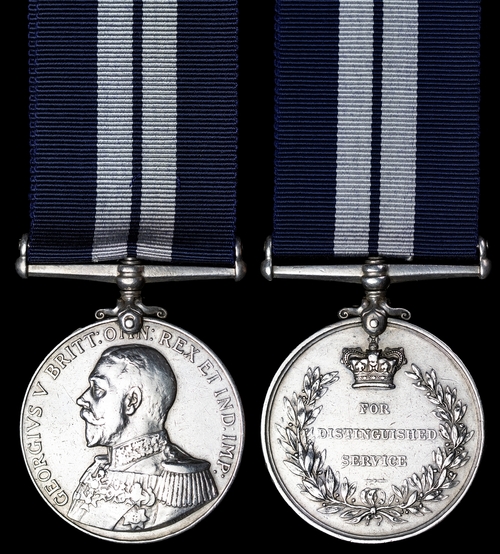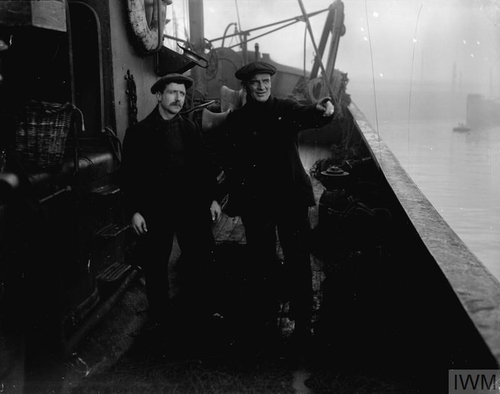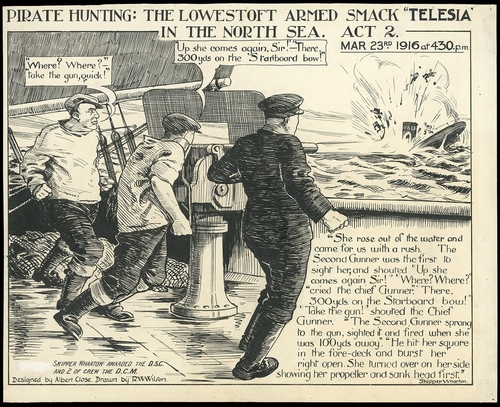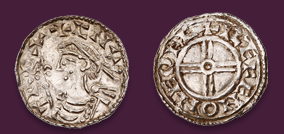Auction: 25002 - Orders, Decorations and Medals
Lot: 160
'Not a man in the smacks when he hoisted sail knew whether he would return. Yet to the casual eye the crews might have been going on a normal fishing trip. They smiled and cracked their jokes and took all the risks that came their way without any flurry or fuss. There were no braver men alive…'
(David Masters, New Tales of the Submarine War refers)
The rare Great War Q-Ship Operations D.S.M. to Second Hand G. W. Cracknell, Royal Naval Reserve, who served aboard Q-ship Boy Alfred when she encountered and allegedly sank a U-boat on 1 February 1917
Boy Alfred (a.k.a. Ethel & Millie) was later famously sunk in the Crisp V.C. action of August 1917, leaving her crew to an unknown fate
Distinguished Service Medal, G.V.R. (D.A. 7420. G. R. Cracknell. LG. Sea. R.N.R. North Sea, 1. Feb. Feb. 1917.), note incorrect second initial and rating, polished, light edge bruising, contact marks, about very fine
This award was entered in the London Gazette on the exact same date and page as the award of the second award Bar to No. J1559 G.R. Cracknell Leading Seaman.
D.S.M. London Gazette 23 March 1917.
George William Percy Cracknell was born on 9 November 1874 at Lowestoft, Suffolk, one of four children born to James Cracknell, a labourer, and his wife Eliza. The young Cracknell first made his living as a labourer for the Great Eastern Railway. The day before his 26th birthday he was married at St. Margaret’s Church in Lowestoft to Ellen Elizabeth Moore, with whom he had been living at 32 Edinburgh Road at the time. The couple went on to have five children, three of whom survived, and the family lived together at 5 Woods Loke in Oulton, Lowestoft.
It was this life that Cracknell was to leave behind with the onset of the Great War. He enrolled with the Royal Naval Reserve on 5 June 1915, at the age of 40. While the exact circumstances under which Cracknell joined the Navy are unknown, many men of Lowestoft - including Skipper Thomas Crisp V.C., D.S.C. - were recruited to join a flotilla of small fishing vessels which were secretly armed, known as Q-ships. It is entirely possible that like Crisp, Cracknell was invited to serve with these secret defensive vessels, which while appearing as innocent fishing boats would be armed and capable of destroying German U-boats.
Cracknell was promoted Second Hand on 19 February 1916, the very same day that he joined H.M. Telesia, an armed smack with one 3-pounder gun under the command of Skipper Walter S. Wharton. Cracknell was potentially on board when Telesia encountered a German U-boat southeast of Lowestoft on 23 March 1916. The submarine fired a shot at the Q-ship, which missed, and in turn received a volley of fire. The first hit the conning-tower, and the second again found its mark at the conning-tower and foredeck and the U-boat began to turn on its side with the propeller visible. The submarine did not surface again, and Wharton received a D.S.C. for the engagement, despite uncertainty whether the craft was actually destroyed. Nevertheless, the encounter enjoyed some publicity and circulated as a propaganda cartoon.
Cracknell later served again with Skipper Wharton aboard H.M. Boy Alfred. Built in 1908 as a fishing smack, Boy Alfred (better known by Ethel & Millie as she was later renamed) was converted in early 1917 into an armed merchantman equipped with a gun.
With Cracknell on board as Second Hand, Boy Alfred, together with H.M. Smack I’ll Try commanded by Skipper Thomas Crisp, first encountered the enemy in the North Sea about thirty miles off the coast from Lowestoft. This meeting occurred on 1 February 1917, the first day of Germany’s unrestricted submarine warfare. Two U-boats closed in on the small fishing vessels, with one of the enemy submarines ordering the crew of Boy Alfred to abandon ship. To play for time to get into proper position Skipper Wharton pretended not to hear, making the Germans repeat the order and successfully closing the distance to only 100 yards between them. Wharton picked his moment and gave the order to ‘Open Fire!’. Sir Henry Newbolt in Submarine and Anti-Submarine takes up the story:
'The first round from the 12-pounder was just short, and the second just over; but having straddled his target, the good man put his third shot into the submarine’s hull, just before the conning-tower, where it burst on contact. The fourth shot was better still; it pierced the conning-tower and burst inside. The U-boat sank like a stone, and the usual wide-spreading patch of oil marked her grave.'
That day also saw Crisp on I’ll Try play a game of cat-and-mouse with the other U-boat, finally striking a hit after a few hours of back and forth. Neither U-boat resurfaced, and at the time Wharton’s strike was considered a certain hit and Crisp’s ‘likely’. However, this has since been debated as the two U-boats thought to have been involved in the exchange, U-62 and U-36, were both seen again at later dates. Nevertheless, Crisp received the D.S.C. for the engagement, Wharton added a bar to his D.S.C., and two D.S.M.s were awarded to the crew of Boy Alfred - one of which was to Cracknell.
As a result of their success in this encounter, the Q-ship programme was subsequently expanded by the Admiralty. According to the idea that the vessels’ names be changed frequently as a form of disguise, I’ll Try became Nelson and Boy Alfred was henceforth known as Ethel & Millie.
The two Q-ships were to meet a fateful end on 15 August 1917. Cracknell had left her at an unknown date, as had Wharton by the time of this action. Ethel & Millie and Nelson - still Skippered by Crisp - were fishing off the coast when they were spotted and attacked by an enemy submarine. Nelson was hit, with Crisp being mortally wounded by a German shell. The dying Skipper ordered his crew, which included his son, to throw his body overboard and abandon ship. He was famously awarded a posthumous V.C. for his bravery. The crew took to the lifeboat and would spend nearly the next two days at sea before being picked up. They bore witness to the only clue of the fate of the men aboard Ethel & Millie, also badly hit by the U-boat:
'Increasing the distance between them, they saw the other smack sink, and watched her crew line up on the deck of the submarine with their hands held above their heads. That was the last ever seen of the crew of the Ethel and Millie. Whether they were deliberately drowned, or whether they were taken into the submarine, which met her end before she could get back, will never be known.' (New Tales of the Submarine War refers)
Cracknell, however, was to escape this mysterious but likely grisly fate which met the rest of the crew of the Ethel & Millie. From his final posting with H.M.S. Halcyon II, on 20 January 1919 Cracknell was dispersed to shore on demobilisation whereupon he returned home to his family and resumed his job as a railway labourer. He was awarded £20 naval prize money in October 1920, a further £30 in 1922 - being discharged from the Reserve that same year - and finally a supplement of £4 in 1923. The 1939 register records Cracknell working as a railway engineer and residing at the same address with Ellen and their son Alfred, now divorced, who worked with his father as a railway engineer.
Cracknell later died at the age of 79 in 1954 and was interred at the Kirkley Cemetery in Lowestoft. He is further entitled to a 1914-15 Star trio; sold together with copied research.
References:
Chatterton, Edward Keble, Q-Ships and Their Story, Sidgwick & Jackson (London, 1922).
Newbolt, Sir Henry John, Submarine and Anti-Submarine, Longmans, Green and Co. (London, 1919).
Masters, David, New Tales of the Submarine War, Eyre & Spottiswoode (London, 1935).
Subject to 20% VAT on Buyer’s Premium. For more information please view Terms and Conditions for Buyers.
Sold for
£750
Starting price
£480









